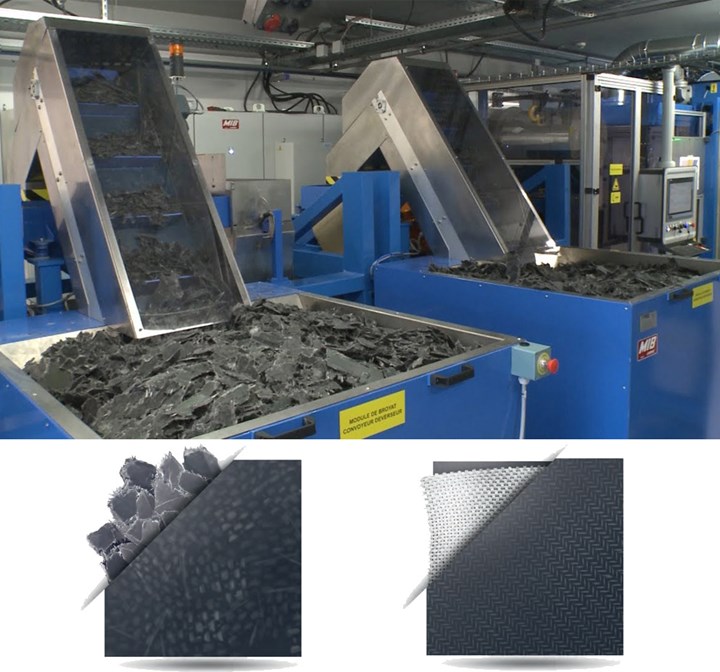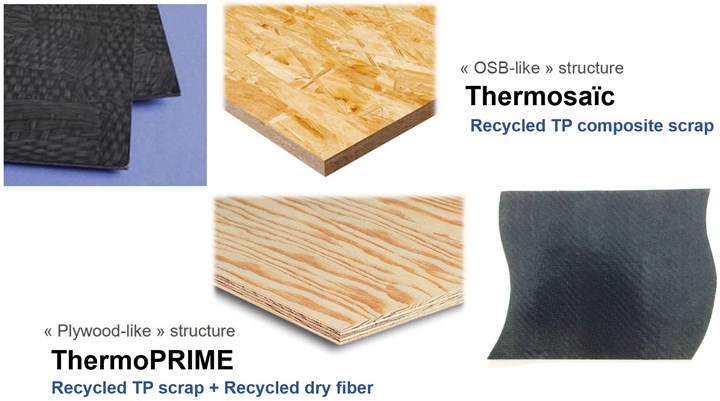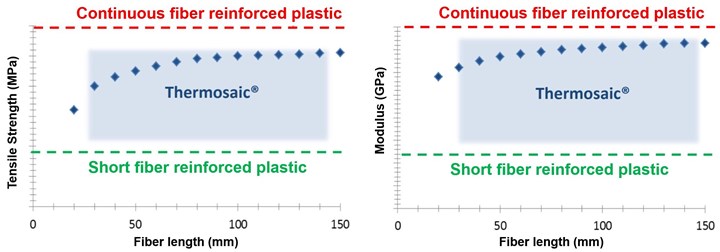Share

SOURCE for all images | Cetim Grand Est
Cetim (Nantes, France) is already well-known for its QSP (Quilted Stratum Process) for industrialized production (< 1-minute cycle time) of thermoplastic composite parts, and also for its QSD (Quilted Stratum Design) software which optimizes such parts, including how to reuse production scrap back into the part. Its third enabling technology is a modular production line for turning thermoplastic scrap with and without fiber reinforcement into organosheet panels that offer desirable properties and cost.
Pilot line at Cetim Grand Est
This thermoplastic composite recycling process was developed by Cetim Grand Est (Mulhouse, France). Formed in 1977 as Cetim Cermat, it merged with CRITT Matériaux Alsace in 2018 to provide technological support for companies in the Alsace Lorraine and Champagne-Ardenne regions of France. “Cetim Grand Est is in charge of recycling technologies for polymers and thermoplastic composites,” explains Clément Callens, business unit manager at Cetim Grand Est for the Mulhouse-based Industry of the Future team, including thermoplastic process and online monitoring projects. “We have fifteen people in this division and work with universities and companies from a wide range of industries, creating interdisciplinary teams to solve challenging problems.”
“The pilot production line we have established in Mulhouse was developed to show the world that this innovative thermomechanical process for recycling production scraps is possible,” Callens continues. “This line is similar to QSP in philosophy: an automated system that is flexible and modular, which enables companies to use the technology in an efficient and cost-effective way. We actually receive scrap from the QSP line in Nantes, or from other customers, and then upcycle it into various organosheet materials and panels, with the goal of maintaining the integrity of the composites for higher performance compared to traditional materials and traditional recycled composites.”
Thermosaïc and ThermoPRIME
The line combines two separate approaches: Thermosaïc and ThermoPRIME.

Thermosaïc takes thermoplastic composite production scrap from cutting and trimming (or from end-of-life parts), coarsely shreds it and then uses a thermomechanical process to convert the shreds into organosheet. “We call it a composite structural panel,” says Callens, “but it’s basically like organosheet.” The term organosheet evolved in Europe to describe fabric-reinforced thermoplastic prepreg, semipreg or preconsolidated blanks that could be thermoformed and overmolded into composite parts. Thermosaïc products are quasi-isotropic, and fiber length is kept as long as possible in order to maximize mechanical properties. “They are in the middle between short fiber sheet and classic organosheet,” Callens notes. “The aim of the technology is to find a good compromise between the shred size and the properties of the panel because you always have to link performance with cost. The process must be flexible and cost-effective, meaning cheaper than virgin material.”

In Cetim’s Thermosaïc process, fiber length is kept as long as possible in order to maximize mechanical properties.
“We use the same process line to make ThermoPRIME structural panels,” he explains. “It is the same basic concept, but in this approach, we begin with unreinforced thermoplastic scrap or end-of-life parts that have been recycled into film. Films made of different materials already are available in the market. We then add virgin, natural, recycled or any other dry continuous fiber to produce an organosheet that has the same properties as virgin material but at a lower cost. The fiber impregnation uses a continuous process which is cheaper versus the batch processing of classic organosheet.”
Cetim’s production line for Thermosaïc and ThermoPRIME is modular, allowing flexibility to accommodate different types of scrap/recycled input and desired finished products.
Demonstrations, cost savings and supply chain
Demonstrations to date have shown more cost savings with higher performance thermoplastics like PEEK (polyetheretherketone) or PPS (polyphenylene sulfide) versus materials like PP (polypropylene), which are already low-cost as virgin materials. In addition to these polymers, Callens’ team has processed PA6 (polyamide6) and developed different kind of glass fiber-reinforced polymer recycled products, working with companies, for example Porcher (Eclose-Badinières, France), to produce Thermosaïc and ThermoPRIME panels. The team is also working on recycled carbon fiber reinforced polymer panels.
How do you see the recycling supply chain developing? “We are working now to transfer this technology to industry, collaborating with Tier 1 suppliers and materials manufacturers,” says Callens. “Cetim Grand Est is working with industry to complete proof of concept and feasibility studies. It is also working, in collaboration with the machine manufacturer partner, to adjust the line to meet the specific needs of customers and work with customers to help define the optimal production modules and parameters.”
Thermosaïc and ThermoPRIME were recognized at JEC World 2018 with the Innovation Award for Sustainable Development. Clément Callens is scheduled to present further details on this technology May 12 at JEC World 2020 (Paris, France).
Related Content
Infinite Composites: Type V tanks for space, hydrogen, automotive and more
After a decade of proving its linerless, weight-saving composite tanks with NASA and more than 30 aerospace companies, this CryoSphere pioneer is scaling for growth in commercial space and sustainable transportation on Earth.
Read MoreComposites end markets: Automotive (2024)
Recent trends in automotive composites include new materials and developments for battery electric vehicles, hydrogen fuel cell technologies, and recycled and bio-based materials.
Read MoreTPI manufactures all-composite Kenworth SuperTruck 2 cab
Class 8 diesel truck, now with a 20% lighter cab, achieves 136% freight efficiency improvement.
Read MoreCo-molding SMC with braided glass fiber demonstrates truck bed potential
Prepreg co-molding compound by IDI Composites International and A&P Technology enables new geometries and levels of strength and resiliency for automotive, mobility.
Read MoreRead Next
Plant tour: Daher Shap’in TechCenter and composites production plant, Saint-Aignan-de-Grandlieu, France
Co-located R&D and production advance OOA thermosets, thermoplastics, welding, recycling and digital technologies for faster processing and certification of lighter, more sustainable composites.
Read MoreVIDEO: High-volume processing for fiberglass components
Cannon Ergos, a company specializing in high-ton presses and equipment for composites fabrication and plastics processing, displayed automotive and industrial components at CAMX 2024.
Read MoreAll-recycled, needle-punched nonwoven CFRP slashes carbon footprint of Formula 2 seat
Dallara and Tenowo collaborate to produce a race-ready Formula 2 seat using recycled carbon fiber, reducing CO2 emissions by 97.5% compared to virgin materials.
Read More

























